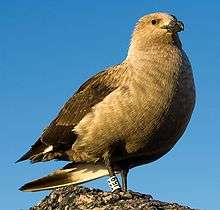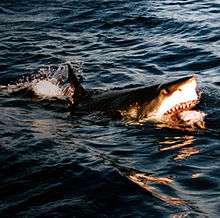List of apex predators
This is a partial list of apex predators—those predators that are not preyed upon as healthy adults in the wild. Full scavengers (e.g. most vultures), although they may not be preyed on either, are not counted as apex predators unless they at least partially depend on capturing live prey. Many species listed here are only apex predators within certain environments, e.g. coyotes are only apex predators when larger predators such as the gray wolf or the brown bear are absent.
Extant predators
These living carnivores or omnivores are apex predators.
.jpg) The African wild dog is a predatory canine found across much of southern and central Africa.
The African wild dog is a predatory canine found across much of southern and central Africa. The lion is a large feline of central, southern, and eastern Africa, as well as the Gir Forest in India. It is Africa's apex predator.
The lion is a large feline of central, southern, and eastern Africa, as well as the Gir Forest in India. It is Africa's apex predator.- The Komodo dragon is the largest living lizard and the apex predator of Komodo.
 The largest surviving carnivorous marsupial, the Tasmanian devil, is both a scavenger and a fierce predator.
The largest surviving carnivorous marsupial, the Tasmanian devil, is both a scavenger and a fierce predator. The tiger is the largest apex predator of South Asia and Southeast Asia, and is also the largest living member of the cat family. It resides in countries on the continent of Asia such as India, Bangladesh, Nepal, China, Korea and Russia.
The tiger is the largest apex predator of South Asia and Southeast Asia, and is also the largest living member of the cat family. It resides in countries on the continent of Asia such as India, Bangladesh, Nepal, China, Korea and Russia.
Terrestrial
- African golden cat (Caracal aurata)
- African rock python (Python sebae)
- American black bear (Ursus americanus)
- Andean cat (Leopardus jacobita)
- Argentine black and white tegu (Salvator merianae)
- Asian golden cat (Catopuma temminckii)
- Asian water monitor (Varanus salvator)
- Bay cat (Catopuma badia)
- Black-headed bushmaster (Lachesis melanocephala)
- Blood python (Python curtus)
- Bornean clouded leopard (Neofelis diardi)
- Brown bear (Ursus arctos)
- Burmese python (Python bivittatus)
- Caracal (Caracal caracal)
- Cat (Felis catus)
- Central American bushmaster (Lachesis stenophrys)
- Cheetah (Acinonyx jubatus)
- Chinese mountain cat (Felis bieti)
- Clouded leopard (Neofelis nebulosa)
- Colocolo (Leopardus colocolo)
- Cougar (Puma concolor)
- Coyote (Canis latrans)
- Crocodile (crocodylinae)
- Crocodile monitor (Varanus salvadorii)
- Culpeo* (Lycalopex culpaeus)
- Diamond python (Morelia spilota spilota)
- Eastern diamondback rattlesnake (Crotalus adamanteus)
- Ethiopian wolf (Canis simensis)
- Eurasian lynx (Lynx lynx)
- Ferret (Mustela potorius furo)
- Fisher (Martes pennanti)
- Fishing cat (Prionailurus viverrinus)
- Flat-headed cat (Prionailurus planiceps)
- Fossa (Cryptoprocta ferox)
- Gaboon viper (Bitis gabonica)
- Geoffroy's cat (Leopardus geoffroyi)
- Gray wolf (Canis lupus)*
- Green anaconda (Eunectes murinus)
- Honey badger (Mellivora capensis)
- Human (Homo sapiens)
- Iberian lynx (Lynx pardinus)
- Inland taipan (Oxyuranus microlepidotus)
- Iriomote cat (Prionailurus iriomotensis)
- Island fox (Urocyon littoralis)
- Jaguar (Panthera onca)
- Jaguarundi (Puma yagouaroundi)
- Jungle cat (Felis chaus)
- Kodkod (Leopardus guigna)
- Komodo dragon (Varanus komodoensis)
- Lace monitor (Varanus varius)
- Least weasel (Mustela nivalis)
- Leopard (Panthera pardus)
- Leopard cat (Prionailurus bengalensis)
- Lion (Panthera leo)
- Long-tailed weasel (Mustela frenata)
- Maned wolf (Chrysocyon brachyurus)
- Marbled cat (Pardofelis marmorata)
- Margay (Leopardus weidii)
- Mulga snake (Pseudechis australis)
- Nile monitor (Varanus niloticus)
- Ocelot (Leopardus pardalis)
- Oncilla (Leopardus tigrinus)
- Pallas's cat (Otocolobus manul)
- Pampas cat (Leopardus pajeros)
- Perentie (Varanus giganteus)
- Red fox (Vulpes vulpes)
- Red-Tailed Boa Constrictor (Boa constrictor)
- Red wolf (Canis rufus)
- Reticulated python (Python reticulatus)
- Sand cat (Felis margarita)
- Scrub python (Morelia amethistina)
- Snow leopard (Panthera uncia)
- Spotted hyena (Crocuta crocuta)
- South American bushmaster (Lachesis muta)
- Sunda clouded leopard (Neofelis diardi)
- Tasmanian devil (Sarcophilus harrisii)
- Tiger (Panthera tigris)
- Wolverine (Gulo gulo)
- Yellow anaconda (Eunectes Noteaus)
- Yellow-headed water monitor (Varanus cumingi)
- Yellow monitor (Varanus flavescens)
* The grey wolf as a species includes the dingo and all domestic dogs.
Aerial

- African harrier-hawk (Polyboroides typus)
- Albatross (Diomedeidae)
- Antarctic skua (Stercorarius antarcticus)
- Barred eagle owl (Bubo sumatranus)
- Bald eagle (Haliaeetus leucocephalus)
- Blakiston's fish owl (Bubo blakistoni)
- Brown fish owl (Bubo zeylonensis)
- Cape eagle owl (Bubo capensis)
- Common raven (Corvus corax)
- Crested eagle (Morphnus guianensis)
- Crowned eagle (Stephanoaetus coronatus)
- Eurasian eagle owl (Bubo bubo)
- Forest eagle owl (Bubo nipalensis)
- Golden eagle (Aquila chrysaetos)
- Great horned owl (Bubo virginianus)
- Great skua (Stercorarius skua)
- Harpy eagle (Harpia harpyja)
- Harris hawk (Parabuteo unicinctus)
- Lappet-faced vulture (Torgos tracheliotos)
- Martial eagle (Polemaetus bellicosus)
- New Guinea harpy eagle (Harpyopsis novaeguineae)
- New Zealand falcon (Falco novaeseelandiae)
- New Zealand harrier (Circus approximans)
- Northern giant petrel (Macronectes halli)
- Osprey (Pandion haliaetus)
- Pel's fish owl (Scotopelia peli)
- Peregrine falcon (Falco peregrinus)
- Philippine eagle (Pithecophaga jefferyi)
- Powerful owl (Ninox strenua)
- Rock eagle owl (Bubo bengalensis)
- Red-tailed hawk (Buteo jamaicensis)
- Shelley's eagle owl (Bubo shelleyi)
- South polar skua[1] (Stercorarius maccormicki)
- Southern giant petrel (Macronectes giganteus)
- Steller's sea eagle (Haliaeetus pelagicus)
- Tawny fish owl (Bubo flavipes)
- Verreaux's eagle owl (Bubo lacteus)
- Wedge-tailed eagle (Aquila audax)
- White-tailed eagle (Haliaeetus albicilla)
Aquatic



.jpg)
- African lungfish (Protopterus annectens)
- Alligator snapping turtle (Macrochelys temminckii)
- Alligator gar (Atractosteus spatula)
- American alligator (Alligator mississippiensis)
- American crocodile (Crocodylus acutus)
- Arapaima (Arapaima)
- Atlantic blue marlin (Makaira nigricans)
- Atlantic goliath grouper (Epinephelus itajara)
- Baiji (Lipotes vexillifer)
- Baikal seal (Pusa sibirica)
- Black caiman (Melanosuchus niger)
- Black grouper (Mycteroperca bonaci)
- Black marlin (Istiompax indica)
- Amazon river dolphin (Inia geoffrensis)
- Bull shark (Carcharhinus leucas)
- Common snapping turtle (Chelydra serpentina)
- Electric catfish (Malapteruridae)
- Electric ray (Torpediniformes)
- False gharial (Tomistoma schlegelii)
- Gharial (Gavialis gangeticus)
- Giant freshwater stingray (Himantura chaophraya)
- Gilded catfish (Zungaro zungaro)
- Goonch catfish (Bagarius yarrelli)
- Goliath tigerfish (Hydrocynus goliath)
- Great barracuda (Sphyraena barracuda)
- Greenland shark (Somniosus microcephalus)
- Great blue heron (Ardea herodias)
- Great hammerhead (Sphyrna mokarran)
- Great white shark (Carcharodon carcharias)
- Humboldt Squid (Dosidicus gigas)
- Kaluga (fish) (Huso dauricus)
- Killer whale (Orcinus orca)
- Lake trout (Salvelinus namaycush)
- Largemouth bass (Micropterus salmoides)
- Leatherback sea turtle (Dermochelys coriacea)
- Leopard seal (Hydrurga leptonyx)
- Lionfish (Pterois)
- Lion's mane jellyfish (Cyanea capillata)
- Loggerhead sea turtle (Caretta caretta)
- Mediterranean monk seal (Monachus monachus)
- Moray eel (Muraenidae)
- Murray cod (Maccullochella peelii)
- Muskellunge (Esox masquinongy)
- Nassau grouper (Epinephelus striatus)
- Nile crocodile (Crocodylus niloticus)
- Nile perch (Lates niloticus)
- Northern pike (Esox lucius)
- Piraíba (Brachyplatystoma)
- Pseudoplatystoma (Pseudoplatystoma)
- Redtail catfish (Phractocephalus hemioliopterus)
- Salmon shark (Lamna ditropis)
- Saltwater crocodile (Crocodylus porosus)
- South Asian river dolphin (Platanista gangetica)
- Semutundu catfish (Bagrus)
- Smallmouth bass (Micropterus dolomieu)
- Sperm whale (Physeter macrocephalus)
- Australian trumpet (Syrinx aruanus)
- Tiger shark (Galeocerdo cuvier)
- Walleye (Sander vitreus)
- Wels catfish (Silurus glanis)
- Whale shark (Rhincodon typus)
- Vundu (Heterobranchus longifilis)
Pagophilic
- Polar bear (Ursus maritimus)
Notes: Animals with an asterisk (*) are only apex predators as introduced species. (**) Humans have debatable status[2]
Extinct apex predators
Non-Avian Dinosaurs
The carnivorous theropods listed below were likely apex predators based on their size and dietary needs. Because very few prehistoric ecosystems are known in detail, these are merely suggestions—larger, more dominant theropods might have lived during the same time in the same place.
 Size comparison of the largest theropod dinosaurs
Size comparison of the largest theropod dinosaurs The largest Coelurosaur, Tyrannosaurus rex could possibly grow to over 40 feet long weigh around 6 to 10 tons and was an apex predator of its environment.
The largest Coelurosaur, Tyrannosaurus rex could possibly grow to over 40 feet long weigh around 6 to 10 tons and was an apex predator of its environment. Spinosaurus was the largest ever terrestrial predator and an apex predator of its environment.
Spinosaurus was the largest ever terrestrial predator and an apex predator of its environment.
- Abelisaurus
- Acrocanthosaurus
- Aerosteon
- Afrovenator
- Alectrosaurus
- Allosaurus
- Albertosaurus
- Altispinax
- Appalachiosaurus
- Aublysodon
- Aucasaurus
- Australovenator
- Austrocheirus
- Becklespinax
- Carcharodontosaurus
- Carnotaurus
- Ceratosaurus
- Chilantaisaurus
- Concavenator
- Cryolophosaurus
- Daemonosaurus
- Daspletosaurus
- Deltadromeus
- Dilophosaurus
- Dryptosaurus
- Dubreuillosaurus
- Eocarcharia
- Eustreptospondylus
- Fosterovenator
- Fukuiraptor
- Giganotosaurus
- Gorgosaurus
- Herrerasaurus
- Ilokelesia
- Indosuchus
- Kryptops
- Labocania
- Liliensternus
- Lourinhanosaurus
- Lythronax
- Majungasaurus
- Mapusaurus
- Megalosaurus
- Megaraptor
- Metriacanthosaurus
- Monolophosaurus
- Nanuqsaurus
- Neovenator
- Orkoraptor
- Poekilopleuron
- Pycnonemosaurus
- Qianzhousaurus
- Quilmesaurus
- Rahiolisaurus
- Rajasaurus
- Sauroniops
- Saurophaganax
- Siamosaurus
- Siamotyrannus
- Siats
- Sinotyrannus
- Sinraptor
- Skorpiovenator
- Spinosaurus
- Spinostropheus
- Staurikosaurus
- Szechuanosaurus
- Tarascosaurus
- Tarbosaurus
- Teratophoneus
- Torvosaurus
- Tyrannosaurus
- Tyrannotitan*
- Utahraptor
- Velociraptor
- Vitakridrinda
- Yangchuanosaurus
- Yutyrannus
- Zhuchengtyrannus
- Zupaysaurus
Other prehistoric terrestrial apex predators

- Agriotherium
- Amphicyon
- Andrewsarchus
- Archaeotherium
- Arctodus simus
- Arctotherium
- Bathornis
- Borhyaena
- Brontornis
- Canis dirus
- Cynotherium sardous
- Daeodon
- Dimetrodon
- Dinofelis
- Entelodon
- Eotitanosuchus
- Epicyon
- Fasolasuchus
- Gorgonops
- Homotherium
- Hyaenodon
- Inostrancevia
- Kaprosuchus
- Kelenken
- Macroeuphractus
- Madtsoia
- Megalania
- Megistotherium
- Miracinonyx
- Homo neanderthalensis
- Ornimegalonyx
- Ornithosuchus
- Panthera onca gombagenzis
- Panthera leo atrox
- Panthera leo melanochaita
- Panthera leo spelaea
- Panthera tigris acutidens
- Paracrax
- Phorusrhacos
- Postosuchus
- Pristichampsus
- Sarkastodon
- Saurosuchus
- Smilodon
- Thylacine
- Thylacoleo
- Thylacosmilus
- Titanis
- Titanoboa
- Ursus maritimus tyrannus
Prehistoric aerial apex predators

- Arambourgiania
- Argentavis
- Haast's eagle
- Harpactognathus
- Hatzegopteryx
- Meganeura
- Meganeuropsis
- Quetzalcoatlus
- Sericipterus
- Teratornis
Prehistoric aquatic apex predators
- Aegisuchus
- Anomalocaris
- Basilosaurus
- Brygmophyseter
- Cameroceras
- Dakosaurus
- Deinosuchus
- Dunkleosteus
- Temnodontosaurus
- Jaekelopterus
- Koolasuchus
- Kronosaurus
- Liopleurodon
- Livyatan melvillei
- Megalodon
- Mosasaurus
- Pliosaurus
- Pterygotus
- Prionosuchus
- Proterogyrinus
- Purussaurus
- Redondasaurus
- Rhizodus
- Sarcosuchus
- Tylosaurus